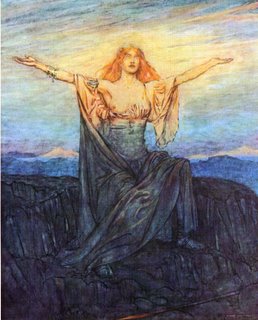Ante Diem VI Idus Februarias

Modern Date : February 8th
Ante Diem VI Idus Februarias
Sixth Day to the Ides of February
This is one of the dies nefasti a day on which no legal action or public voting could take place. The dies nefasti of February were days of religious ceremony honoring the dead and heralding the rebirth of the Spring and its associated fertility.
February is a month sacred to the gods Mars (as Quirinus, or Romulus) and Juno, the wife of Jupiter. Juno (Hera, was the mother of Mars. Mars was known to the Greeks as Ares, the god of war. The war god was wild and ungovernable, a god who glorified in strife for its own sake and revelled in slaughter. He was thought to gloat over the death and destruction he caused. He was typically accompanied by his two sons Deimos (Fear or Terror) and Phobos (Dismay or Flight from Fear). The Romans held a milder, more honorable view of Mars, honoring him as the son of Zeus and the father of Romulus.
Juno, also called Saturnia and known as Hera by the Greeks, was the daughter of Cronus (Saturn) and regarded as a paragon of motherly virtues. She was the divinity of sacred marriage and childbirth, and was prone to violent wrath at every violation of her marriage bed with Zeus.
Valentinian's father, Constantius, was made a colleague in the empire this day in 421 AD, but he died the same year.
February is also a month in which particular reverence was shown to the spirits of deceased ancestors. This was a month devoted to fertility, both of men and women, and of the land.
Star festival
The Chinese Star festival is a nighttime celebration, giving thanks to the stars influencing human fate. The master of the house offers prayers to the star that governed his birth and then lights one hundred eight small lamps on a special altar. Each son in the household also offers prayers to the star of his birth, relighting three lamps as the lamps of his father go out. The brightness of the flames dictates the outcome of the year.
Narvik Sun Pageant
The Narvik Sun Pageant is a festival held in Norway in honor of the Sun Goddess, Sunna. The festival begins at dawn and continues until evening shadows darken the sky. Sunna is the Norse Goddess of the Sun, also known as Sól, though some hold that Sól is the mother and Sunna Her daughter. In Norse mythology, the Sun is female while the Moon is male. When the world was created from the body of the dead giant Ymir by the triad of Odin, Vili, and Ve, the Sun, Moon and Stars were made from the gathered sparks that shot forth from Muspellsheim, the Land of Fire.
Sól ("Mistress Sun"), drives the chariot of the Sun across the sky every day. Pulled by the horses Allsvinn ("Very Fast") and Arvak ("Early Rising"), the Sun-chariot is pursued by the wolf Skoll. It is said that sometimes he comes so close that he is able to take a bite out of the Sun, causing an eclipse. Sol's father is Mundilfari, and She is the sister of Måni, the Moon-god, and the wife of Glaur or Glen ("Shine"). As Sunna, She is a healer.
At Ragnarok, the foretold "Twilight of the Gods" or end of the world, it is believed the Sun will finally be swallowed by Skoll. When the world is destroyed, a new world shall be born, a world of peace and love, and the Sun's bright daughter shall outshine Her mother.
Needle Memorial
In Japan, in a ritual that goes back 1500 years, women dress in kimonos and take the sewing needles that have broken in the previous year to the local Buddhist shrine where a three-tiered altar has been set up. The lower tier displays sewing accessories: scissors, thimbles, thread, etc. The top tier holds offerings of seasonal fruit and white mochi. On the center tier is a vast slab of tofu into which the broken needles are plunged. Priests sing sutras to comfort the needles, heal their broken spirits and thank them for work well done. No sewing takes place on this day.

0 Comments:
Post a Comment
<< Home